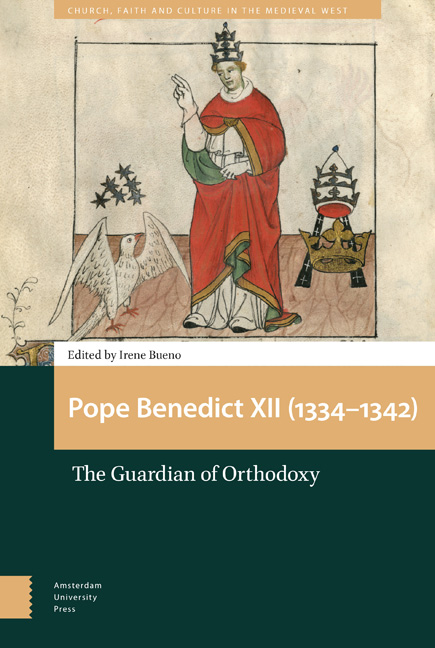Book contents
- Frontmatter
- Contents
- Abbreviations
- List of Illustrations
- Introduction: Benedict XII, the Guardian of Orthodoxy
- 1 Jacques Fournier and Thirteenth-Century Inquisitorial Methods
- 2 Recovering a Theological Advice by Jacques Fournier
- 3 Benedict XII and the Beatific Vision
- 4 A New Seat for the Papacy: Benedict XII, Avignon, and the Comtat Venaissin
- 5 In the Footsteps of St Peter: New Light on the Half-Length Images of Benedict XII by Paolo da Siena and Boniface VIII by Arnolfo di Cambio in Old St Peter’s
- 6 Benedict XII and Italy: Restoring Orthodoxy and Consolidating Papal Sovereignty after John XXII
- 7 Benedict XII and the Outbreak of the Hundred Years’ War
- 8 Benedict XII and the Crusades
- 9 Benedict XII and the Partes Orientis
- Index of Names
- Index of Subjects
5 - In the Footsteps of St Peter: New Light on the Half-Length Images of Benedict XII by Paolo da Siena and Boniface VIII by Arnolfo di Cambio in Old St Peter’s
Published online by Cambridge University Press: 11 December 2020
- Frontmatter
- Contents
- Abbreviations
- List of Illustrations
- Introduction: Benedict XII, the Guardian of Orthodoxy
- 1 Jacques Fournier and Thirteenth-Century Inquisitorial Methods
- 2 Recovering a Theological Advice by Jacques Fournier
- 3 Benedict XII and the Beatific Vision
- 4 A New Seat for the Papacy: Benedict XII, Avignon, and the Comtat Venaissin
- 5 In the Footsteps of St Peter: New Light on the Half-Length Images of Benedict XII by Paolo da Siena and Boniface VIII by Arnolfo di Cambio in Old St Peter’s
- 6 Benedict XII and Italy: Restoring Orthodoxy and Consolidating Papal Sovereignty after John XXII
- 7 Benedict XII and the Outbreak of the Hundred Years’ War
- 8 Benedict XII and the Crusades
- 9 Benedict XII and the Partes Orientis
- Index of Names
- Index of Subjects
Summary
Abstract
This chapter offers a new understanding of papal self-fashioning strategies between the late-thirteenth and the mid-fourteenth centuries. On the basis of hitherto neglected or misunderstood sources, it demonstrates that the original location of the half-length image of Benedict XII (1341) in Old St Peter's differed considerably from earlier reconstructions. This prompts a reinterpretation of the sculpture's original function and of the message that it conveyed about the role of the pope by materializing his presence in Rome at a time of contested absence. Furthermore, the reappraisal of monumental Petrine ‘presences’ in the basilica leads not only to revise the traditional reading of Arnolfo di Cambio's half-length image of Pope Boniface VIII as associated with the papal tomb, but also to offer a new proposal for its original setting and function. These findings transform our knowledge of the pilgrim experience in Old St Peter’s, whilst throwing new light on the sacred topography of the most important basilica of Western Christendom.
Keywords: Portraiture, sacred topography, papal authority, sculpture, St Peter, St Peter’s, Rome, Benedict XII, Boniface VIII, Arnolfo di Cambio, Paolo da Siena
‘He was a very corpulent man, and fat, and large, and red.’ This less than flattering description of Benedict XII was, as the Roman chronicler known as the Anonimo Romano explicitly states, based on the actual half-length image of the Pontiff (Figure 1), located as it was in the most central of positions, above the main door on the inner façade of Old St Peter’s. Writing less than two decades after the portrait had been sculpted, the Anonimo could not be more specific on this point: ‘His accurate image was in St Peter’s, within the church, above the main door of the main nave.’ On seeing the marble portrait, which by then had been removed to the Vatican Grottoes, the seventeenth-century Roman antiquarian Francesco Maria Torrigio similarly commented that the image of the pope, in the act of blessing and holding the keys, was ‘painted in red’. Surprising as it might sound, especially when looking at the surviving image, of dazzling white marble, the statement finds confirmation in the fact that the payment records attest to the contribution of a painter, responsible for the colouring of both the papal image and the Gothic aedicule (fenestra) which framed it (Figure 2).
- Type
- Chapter
- Information
- Pope Benedict XII (1334–1342)The Guardian of Orthodoxy, pp. 131 - 166Publisher: Amsterdam University PressPrint publication year: 2018



